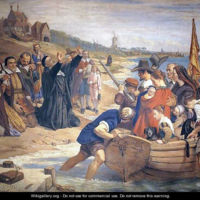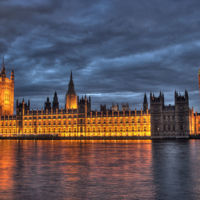Description
After the Palace of Westminster was destroyed by fire in 1834, a Royal Commission was set up in 1841 to deal with the question of how to decorate the new palace (by then already under construction). A series of competitions and exhibitions of historical and literary subjects and figures resulted, in forms such as sculpture, frescoes and charcoal drawings, and their exhibiting were patronised by Royalty and large public crowds alike. In June 1846, an oil painting competition was announced, and an exhibition of 120 paintings took place the following year. Four were chosen: F. R. Pickersgill's 'Burial of Harold,' G. F. Watts' 'Alfred inciting the Saxons to prevent the Landing of the Danes', J. Cross' 'Richard Coeur-de-Lion forgiving Bertrand de Gourdon' and W. A. Knell 'The Battle off Cape St. Vincent’.
Charles Lucy’s painting, ‘The Departure of the Pilgrim Fathers’, was not chosen for the rebuilding, but he was one of three artists to win a third-class prize. His 10ft by 13ft painting depicted the Separatists mournfully praying below their minister, John Robinson, before they departed Delfshaven for Southampton. Despite not winning the ultimate prize, Lucy’s painting elicited a lot of interest in Britain. An engraving was made in 1852 and, the following year, the original painting itself began its own journey across England. It was first exhibited in the Concert Hall (Lord Nelson Street) of Liverpool in October 1853, where the Rev HS Brown gave an accompanying lecture on the Pilgrim Fathers – waxing lyrical about how their persecution had led to forming of the United States, ‘the now giant power of the western world’. In the following year the painting was further exhibited across the industrial north in Manchester, Bolton, Bradford, Leeds, Huddersfield, before making its way to the midlands (Birmingham and Worcester), and further south to Exeter. In each town or city, the exhibition and lectures became an opportunity for civic and religious communities to reflect on the power and importance of the Mayflower story. Today, Lucy’s painting hangs in the Pilgrim Hall Museum in Plymouth, Massachusetts.
Around the same time as the oil painting competition, six artists were also appointed to paint a series of historical frescoes in the new House of Lords. The Commissioners were looking for subjects that were ‘illustrative of the functions of the House of Lords and the relation in which it stands to the Sovereign’. Charles West Cope, one of the artists, chose the same Delfshaven scene for a fresco in the ‘Peers’ corridor’. In contrast to Lucy’s work, however, in Cope’s final mural (unveiled in 1856) Robinson is praying on the shore as the Pilgrims are on a rowing boat named ‘Mayflower’ (an incorrect detail, it being the Speedwell that took the Pilgrims back from Holland to England). One of the Pilgrims carries a flag emblazoned with ‘Freedom of Worship’. In the eyes of contemporary Britons, than this being a negative story about religious intolerance it was a demonstration of how Victorian ideas about the British spirit were engrained in both the past and present. Whether Cope was inspired by Lucy or not, his painting demonstrates how British elites at this time – despite less than always cordial relations with the USA – could claim the Pilgrim Fathers for themselves.
You can see Cope’s painting in situ here: https://www.parliament.uk/visiting/virtualtour/
Source
‘The Nottinghamshire Pilgrim Fathers’, Nottinghamshire Guardian (3 November 1854), 5.
S. R. Boase, ‘The Decoration of the New Palace of Westminster, 1841-1863’, Journal of the Warburg and Courtauld Institutes, Vol. 17, No. 3/4 (1954).
Sargent Bush, Jr, ‘America’s origin myth: remembering Plymouth Rock’, American Literary History, vol. 12, no. 4 (2000).


